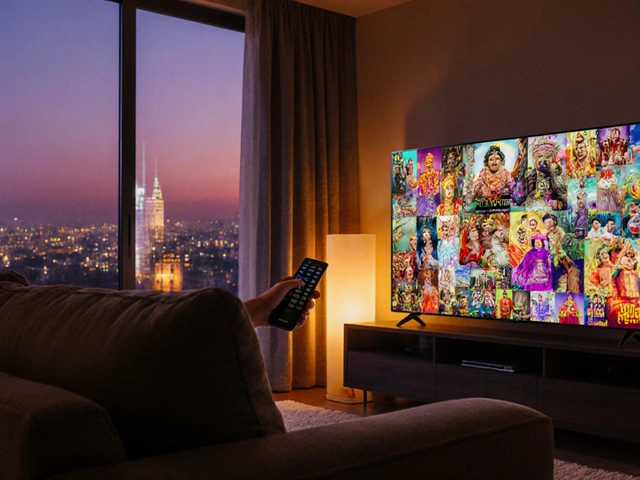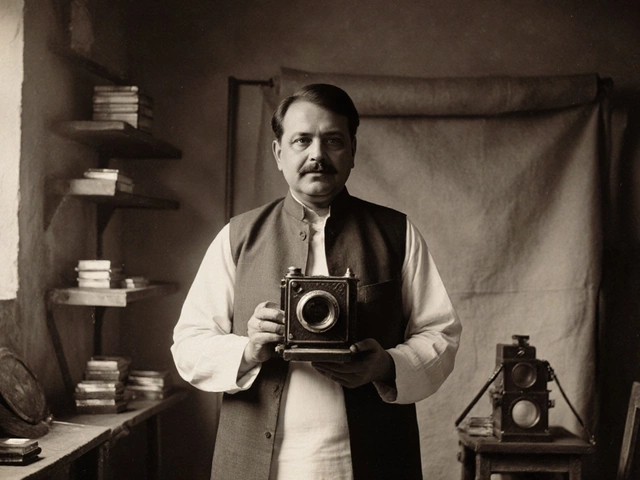Netflix India Market Size Estimator
Market Growth Calculator
Enter current data points to estimate Netflix's projected growth in the Indian SVOD market.
Projected Market Growth
Current Subscribers
55M
Projected Subscribers
-
Market Value (2027)
$4.5B
Based on current data, India's SVOD market is projected to reach $4.5 billion by 2027 with a CAGR of 21%. This growth is driven by smartphone penetration, affordable pricing, and increasing cultural demand for diverse content.
When you open Netflix and scroll through the library, you’ll notice an ocean of Indian titles - from classic Bollywood blockbusters to Tamil thrillers and Marathi dramas. It isn’t a coincidence; Netflix has purposefully built a massive Indian catalogue to tap into a fast‑growing market, satisfy a culturally diverse audience, and stay ahead of fierce competition. Below we break down the why, how, and what‑next for this strategy.
Key Takeaways
- India is the world’s largest and fastest‑growing SVOD market, offering a huge subscriber base for Netflix Indian movies.
- Netflix combines licensing deals, co‑productions, and original films to fill its catalogue.
- Regional language content (Tamil, Telugu, Malayalam, etc.) drives higher engagement than Hindi‑only titles.
- Competitive pressure from Disney+ Hotstar and Amazon Prime Video forces Netflix to invest heavily in local content.
- Future growth will hinge on data‑driven personalization, localized pricing, and more regional originals.
Let’s dive into the five jobs readers typically want to finish after landing on this page: understand the market size, learn how Netflix acquires Indian movies, see how competition shapes the catalogue, discover what it means for viewers, and get a glimpse of upcoming trends.
1. The Indian SVOD Landscape - Numbers That Speak
Netflix is a global subscription video‑on‑demand (SVOD) platform that, as of 2025, serves more than 230 million subscribers worldwide. In India alone, the subscriber count crossed 55million, making it the second‑largest market after the United States. According to a 2024 industry report, the Indian SVOD market is projected to reach $4.5billion by 2027, growing at a compound annual growth rate (CAGR) of 21%.
Three forces fuel this surge:
- Smartphone penetration: Over 70% of Indian households own a smartphone, and 55% use mobile data to stream video.
- Affordability: Tiered pricing-starting at ₹199 per month-makes streaming accessible to middle‑class families.
- Cultural demand: India produces more than 2,000 films a year across multiple languages, creating a deep well of content.

2. How Netflix Builds Its Indian Catalogue
Netflix doesn’t just buy existing titles; it follows a three‑pronged approach:
- Licensing deals: Netflix secures streaming rights from major studios like Yash Raj Films, Dharma Productions, and regional powerhouses such as Sun TV Network. These deals often cover a 2‑ to 5‑year window, allowing Netflix to showcase recent hits.
- Co‑productions: By partnering with local production houses, Netflix shares costs and gains creative input. For example, the 2023 thriller Gadar 2: The Return was a Netflix‑Sun Pictures co‑production, splitting the budget 60/40.
- Originals: Netflix funds fully owned projects that debut exclusively on the platform. Success stories include RRR (Telugu), Rocketry: The Nambi Effect (bilingual), and the Marathi drama Sairat 2. Original budgets range from $3million for niche regional films to $25million for pan‑Indian blockbusters.
All three strategies feed the library, but originals are key to differentiation because they can’t be pulled by competitors.
3. Regional Diversity - Beyond Bollywood
While Bollywood (Hindi cinema) is the most recognizable brand, Netflix’s real growth driver is regional language content. Here’s a quick breakdown:
| Language | # of Titles | Top Performers |
|---|---|---|
| Tamil | 180 | Soorarai Pottru, Master |
| Telugu | 150 | RRR, Pushpa |
| Malayalam | 95 | Kumbalangi Nights, Jana Gana Mana |
| Marathi | 70 | Sairat 2, Killa |
| Hindi (Bollywood) | 320 | Pathaan, Gangubai Kathiawadi |
Data from Netflix’s internal analytics (shared during a 2024 industry summit) shows that regional titles enjoy a 27% higher completion rate than Hindi‑only movies, indicating stronger viewer engagement.
4. Competition Calls the Shots - Netflix vs. Disney+ Hotstar
Netflix isn’t the only player courting Indian viewers. Disney+ Hotstar, backed by The Walt Disney Company, holds a dominant 33% market share, mainly thanks to live sports and an extensive library of Hindi and regional titles. To stay competitive, Netflix has upped its investment budget to $1.2billion annually for Indian content (up from $800million in 2022).
| Metric | Netflix | Disney+ Hotstar |
|---|---|---|
| Subscriber base (India) | 55million | 68million |
| Annual Indian content spend | $1.2billion | $1.0billion |
| Original Indian titles (2024) | 45 | 38 |
| Regional language titles | 620 | 540 |
The competition forces Netflix to keep its library deep and fresh. When a big Bollywood release lands on Disney+ Hotstar, Netflix often counters with a regional original or a high‑profile licensing acquisition within weeks.

5. What This Means for the Everyday Viewer
For you, the benefits are tangible:
- More choices: Whether you speak Hindi, Tamil, or Malayalam, Netflix offers a curated shelf that respects your language.
- Higher quality: Netflix’s originals usually have larger budgets, better visual effects, and global marketing push.
- Personalized recommendations: Netflix’s AI learns from your viewing habits across Indian and international titles, surfacing hidden gems you’d otherwise miss.
- Access to global hits: International movies often get Hindi or regional dubbing, widening the cultural exchange.
However, there are downsides. Licensing deals expire, causing some beloved classics to disappear after a few years. Also, the focus on new originals means older gems sometimes aren’t prioritized for restoration or subtitles.
6. Looking Ahead - Trends Shaping Netflix’s Indian Play
Industry analysts predict three major trends for the next three years:
- Hyper‑local storytelling: Micro‑regional narratives (e.g., Bhojpuri, Odia) will receive dedicated budgets, aiming for niche loyalty.
- Ad‑supported tier: To capture price‑sensitive users, Netflix may roll out a cheaper, ad‑based plan in India, mirroring its U.S. model.
- Co‑creation with creators: Netflix is piloting a “creator‑fund” that allows independent filmmakers to pitch concepts directly, shortening the production pipeline.
These moves will likely deepen Netflix’s catalogue, ensuring the platform remains a go‑to destination for Indian movies of all flavors.
Frequently Asked Questions
Why does Netflix focus so heavily on regional Indian movies?
Regional titles generate higher engagement and completion rates, and they tap into language‑specific audiences that are less saturated than the Hindi market. This helps Netflix grow subscriber numbers outside the major metros.
How does Netflix decide which Indian movies to license?
The decision combines data on viewership trends, social media buzz, and revenue potential. Titles that performed well on theatrical release or streaming platforms in the last 12 months get priority.
Are Netflix’s Indian originals exclusive forever?
Yes, original productions are exclusive to Netflix for the duration of the licensing agreement, which is typically perpetual unless sold to another platform under special circumstances.
What’s the biggest Indian film ever on Netflix?
As of 2025, RRR holds the record for the highest viewership hours among Indian titles on Netflix, crossing 150million hours within the first month of release.
Will Netflix add more ad‑supported plans in India?
Industry rumors and early test launches suggest an ad‑supported tier is likely to appear in 2026, aiming to attract price‑sensitive users while generating new revenue streams.






Post A Comment